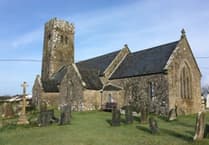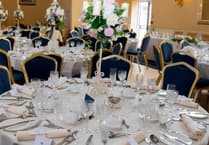A former pupil at Tenby’s Greenhill School who now lives in Falmouth and works at HMNB Devonport has been awarded a rare Gold Valedictory Certificate, from the Head of The Royal Navy, First Sea Lord and Chief of the Naval Staff, Admiral Tony Radakin KCB ADC. The award comes at the end of a long and distinguished career lasting 45 years.
Chief Petty Officer Paul Roberts grew up in Tenby, where he attended Greenhill School and was a member of Tenby Sea Cadets. He joined the Royal Navy, at HMS Raleigh, South East Cornwall, in August 1976, for his initial training before completing his Fleet Air Arm Air Engineer trade training, on 706 Naval Air Squadron (NAS) Sea Kings, at RNAS Culdrose in West Cornwall.
Once qualified, he stayed at Culdrose moving onto 824 NAS, a frontline Sea King squadron that frequently embarked on board the carriers HMS Bulwark and HMS Hermes. During this time he travelled to the USA on many exercises, visiting several ports across the Atlantic. He saw time as well on board the Royal Fleet Auxiliaries (RFAs) Fort Grange and Olwen in the Far East and Mediterranean.
It was in the Far East as well, with RFA Olwen, that he sailed through Typhoon Orchid off the Philippines in 1980, near to where the British owned Super tanker MV Derbyshire went down with the loss of all hands, the largest British ship ever to be lost at sea. Paul also spent time alongside at the Port of Olongapo in the Philippines for an extended maintenance period, before escorting the destroyer HMS Bristol to the Gulf as a show of strength.
Leaving the Far East, Paul flew home from Singapore to get married in October 1980.
After his Leading Hand’s leadership course, he re-joined 824 Sqn’s D Flight who were flying the first Airborne Early Warning Sea Kings for service operational embarked on the newly-commissioned aircraft carrier HMS Illustrious, and deployed to the Falkland Islands, in 1982.
HMS Illustrious relieved HMS Invincible and whilst the main runway at the Mount Pleasant base was being built, spent 96 days on station, before sailing back to the UK via Puerto Rico and Fort Lauderdale.
Paul was then selected for Artificer training and after his Petty Officer Leadership course spent time based once again at RNAS Culdrose in the machine shop, then moved on to Mobile Aircraft Support Unit (MASU) (now 1710 NAS) to carry out large repairs to tri-service rotary wing aircraft, responsible for all types and marks of the UKs helicopter fleets. He was called on to deploy all over the UK and across the globe. During this period he was awarded a General Service medal for Northern Ireland and a NATO medal for service in the Balkans, and in 1997 flew out to every job the unit attended.
In October 1999, he left regular service and joined the Royal Naval Reserve Air Branch, which supports the Fleet Air Arm (FAA). And in 2003 took up a full-time Reserve Service commitment at Culdrose, before re-joining the regular FAA in September 2004.
Back on the books of MASU for Arctic Warfare Survival training in Norway, he deployed on operational service in Afghanistan, between 2006 – 2008. A particular highlight of this time was leading a 5,000 man-hour repair task on a Commando Sea King Mk 4 which had been damaged near Kandahar.
Paul became the senior supervisor in the Aircraft Composite Repair Facility at RNAS Culdrose after his tour with MASU, prior to volunteering to support the Marine Engineering facility in HMNB Devonport from 2016, where he has been awarded Babcock’s Marine Efficiency award for his work during HMS Kent’s latest refit and has kept himself busy, by offering military support to the annual Ten Tors event across Dartmoor in 2018 an 2019.




